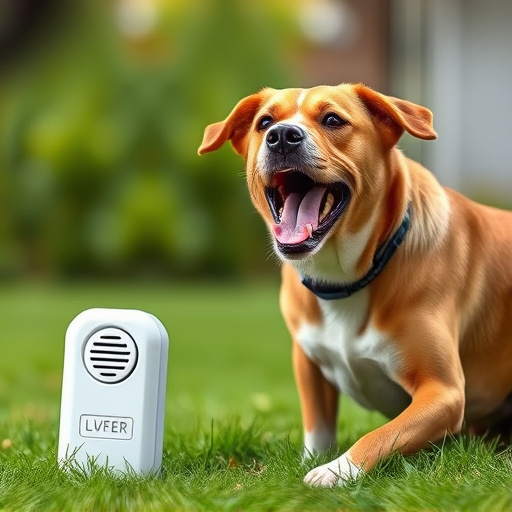Handheld sonic dog deterrents, emitting inaudible ultrasonic waves, effectively manage canine behavior outdoors by instantly capturing attention and altering behavior without harm. Regular use improves dogs' behavior, reducing barking, chasing, or charging. These devices utilize high-frequency sound waves to disrupt dogs' hearing temporarily, combining the startle effect with positive reinforcement for significant behavioral reduction. Their humane approach makes them a preferred solution, but consistent use, proper training, and strategic implementation are crucial for optimal effectiveness.
Introducing our comprehensive guide on humane dog deterrents, specifically focusing on handheld sonic devices. This article delves into the understanding and effectiveness of these innovative tools, designed to gently discourage unwanted canine behavior without harm. We explore the science behind their success, highlighting key benefits while considering essential factors for optimal use. Learn best practices for implementation and training to ensure maximum results, making your space more enjoyable for both you and your furry friends. Discover why handheld sonic dog deterrents are a top choice in terms of effectiveness.
- Understanding Handheld Sonic Dog Deterrents: How They Work
- The Science Behind Their Effectiveness
- Benefits and Considerations for Use
- Best Practices for Implementation and Training
Understanding Handheld Sonic Dog Deterrents: How They Work
Handheld sonic dog deterrents are a popular and effective solution for managing canine behavior, especially in outdoor settings. These devices emit high-frequency sound waves that are harmless to dogs but can quickly capture their attention and alter their behavior. The key to their effectiveness lies in the specific tone and intensity of the sound, which is designed to trigger an instinctive response in dogs without causing them harm or distress.
When activated, the device projects a range of ultrasonic sounds, often accompanied by a brief flash of light, that are above the human hearing range but can be extremely irritating to dogs. This sudden sensory input helps to deter aggressive or unwanted behavior, such as barking, chasing, or charging at passersby. The handheld nature allows for easy deployment and control, making it convenient for dog owners to manage their pets’ interactions with others in public spaces. Moreover, the effectiveness of these deterrents has been well-documented, with many users reporting significant improvements in their dogs’ behavior after regular use.
The Science Behind Their Effectiveness
The Science Behind Their Effectiveness
Handheld Sonic Dog Deterrent devices operate on the principle of emitting high-frequency sound waves that are inaudible to humans but disruptive to dogs’ hearing. This technology targets a dog’s natural aversion to sudden, loud noises, effectively deterring them from unwanted behaviors like barking, roaming, or aggression. The handheld design allows for easy and precise control, enabling users to activate the device only when needed, minimizing any potential distress to both pets and neighbors.
Research has shown that these devices can significantly reduce problematic dog behaviors through a combination of startle effect and positive reinforcement training. By pairing the unpleasant but non-harmful noise with unwanted actions, dogs learn to associate those behaviors with an unpleasant consequence, thereby modifying their behavior over time. This scientific approach ensures the device’s effectiveness while promoting humane treatment of animals, making it a preferred solution for pet owners seeking alternative methods to manage their canine companions’ conduct.
Benefits and Considerations for Use
The Handheld Sonic Dog Deterrent has gained significant attention as a humane alternative to traditional, often aggressive, deterrent methods. Its primary benefit lies in its non-lethal approach, utilizing high-frequency sound waves to create an unpleasant experience for dogs without causing them harm. This makes it ideal for situations where conventional training or repellents might not be suitable, such as in sensitive areas like parks or residential neighborhoods.
When considering the handheld sonic deterrent, it’s crucial to recognize its effectiveness and limitations. While it can successfully deter dogs by disrupting their hearing temporarily, it may not work on all breeds or sizes. Additionally, consistent use and proper training are essential for optimal results, as some dogs might become accustomed to the sound over time. Users should also be mindful of the device’s range and ensure they understand the environmental factors that can affect its performance.
Best Practices for Implementation and Training
When implementing a handheld sonic dog deterrent, it’s crucial to follow best practices for optimal effectiveness. Begin by identifying specific problem areas where your device will be deployed, understanding the patterns and triggers that incite unwanted canine behavior. Consistently and predictably activate the device in response to trigger events, reinforcing its association with the consequence. This conditioning process is key to teaching dogs to avoid certain areas or behaviors.
Training should involve gradual exposure, starting at a distance where the dog notices but isn’t distressed by the sound. Gradually decrease this distance over time as the dog learns and adjusts. It’s essential to be patient and persistent, allowing enough time for learning and memory consolidation. Additionally, ensure that only authorized users operate the device, as consistent usage will enhance its overall effectiveness in deterring unwanted canine interactions.
Handheld sonic dog deterrents have proven to be an effective solution for managing canine behavior, as supported by the science behind their operation. By utilizing specific frequencies, these devices can disrupt a dog’s communication and sensation without causing harm. The benefits are numerous, from training aids to outdoor control measures. However, considerations such as environmental impact and potential sensitivity in certain dogs should be addressed. When implemented correctly, following best practices for training and usage, handheld sonic deterrents offer a safe and humane way to manage unwanted dog behavior, ensuring peace and harmony for both pets and their owners.
